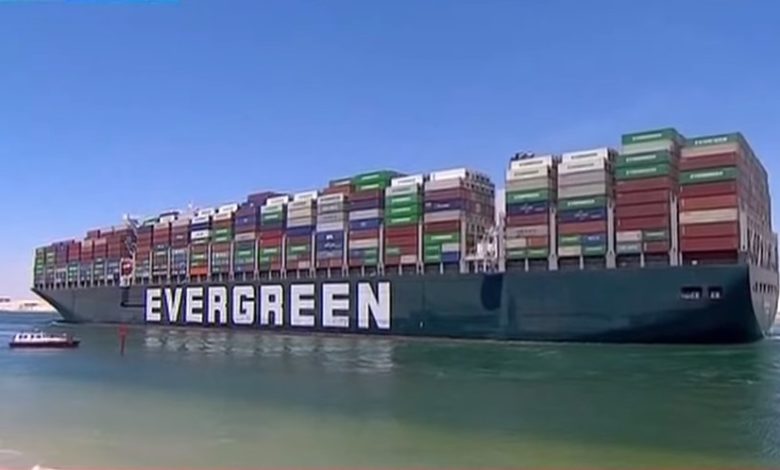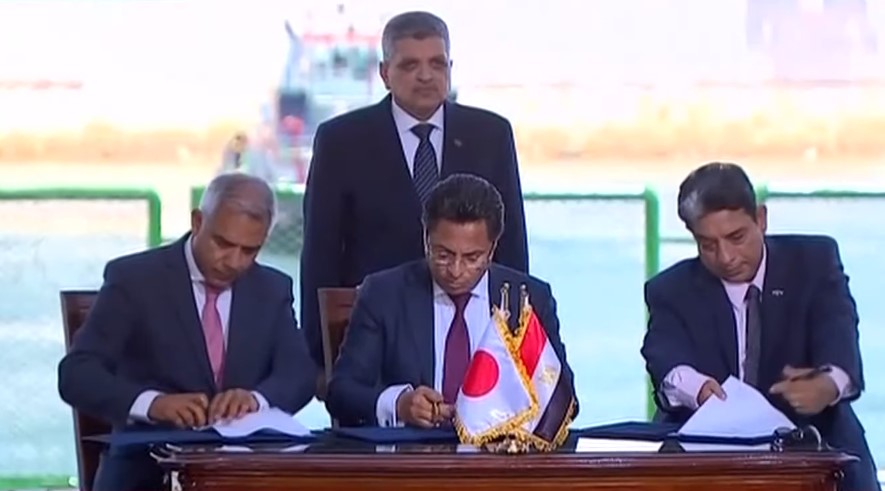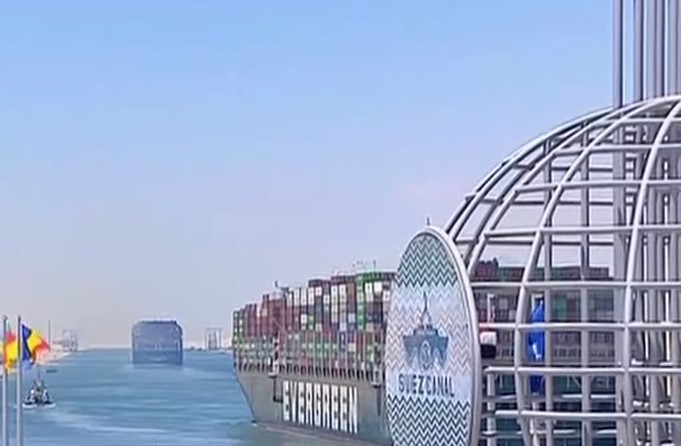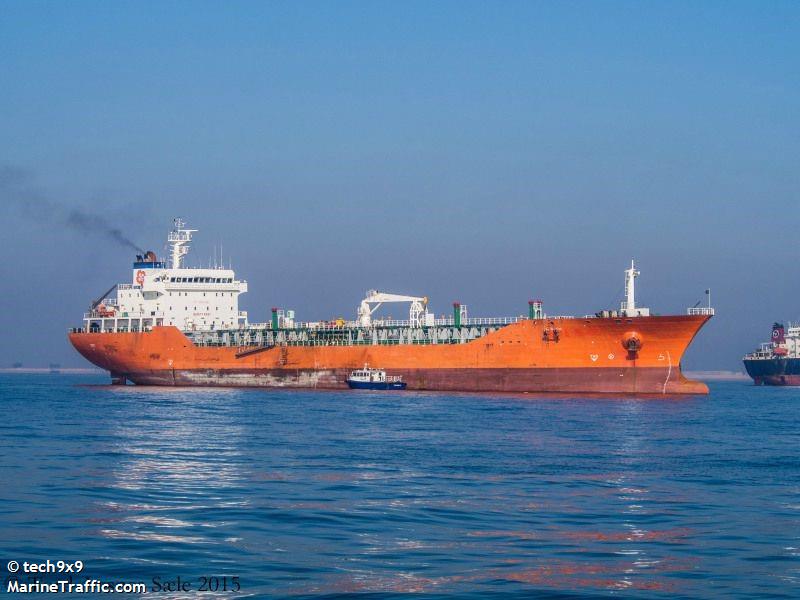Ever Given weighs anchor and heads towards Europe

A ceremony was held in Egypt to mark an agreement on compensation for the Ever Given fiasco, with the giant boxship now on the move to leave the country where it has been in since a transit of the Suez Canal went badly wrong on March 23.

The ship was responsible for this year’s most high profile accident when it became lodged across the canal in high winds for six days at the end of March. Egyptian authorities and the Japanese shipowner have been negotiating a compensation package for its release ever since with the Suez Canal Authority (SCA) initially demanding $916m, something it has since scaled back.
No details have been revealed on the size of the compensation package thrashed out between the SCA and the ship’s Japanese owner, Shoei Kisen, with the Wall Street Journal suggesting earlier the figure stood at $200m.
The SCA lawyer, Khalid Abubakr said on Wednesday that the authority intends to keep the terms of the agreement confidential.
The giant ship, with more than 18,000 containers onboard, will likely make for its original next port of call, Rotterdam, having undergone inspections at Port Said where it is scheduled to arrive this evening. The 20,388 teu ship is being escorted through the northern section of the canal today by two tugs.

General average was declared on the vessel months ago meaning customers will have to put up security to receive their cargo, with insurance executives warning at a webinar last week that the Ever Given will likely be the largest general average casualty in history.
“We recognise the importance of the cargo on board the vessel and are sorry for the impact of voyage delays on the cargo, but the delays are minimised and the vessel has been released as quickly as possible. We would like to report to all cargo-related parties that we have taken every possible measure to ensure that this is done,” Shoei Kisen said in a statement on Wednesday.
In the weeks following the accident Egyptian authorities detailed plans to widen and deepen the southern part of the Suez Canal where the Ever Given ran aground.
In a televised ceremony in Ismailia, SCA chairman Osama Rabie said the Ever Given incident was a “difficult test” for Egypt “under the eyes of the world”.
Rabie also said that the agreement included the payment of a lump sum, without disclosing the numbers. He added the SCA would not change rules for passage of ships in bad weather, but that the Ever Given’s grounding had accelerated plans for the waterway’s expansion.

 fiasco, with the giant boxship now on the move to leave the country where it has been in since a transit of the Suez Canal went badly wrong on March 23.
fiasco, with the giant boxship now on the move to leave the country where it has been in since a transit of the Suez Canal went badly wrong on March 23.
Good day Mr Chambers,
Whilst I appreciate all the reporting you do for the maritime world I feel it is most unfair to blame ‘the ship’ – in thIs case EVER GIVEN – for the disruption that followed the grounding. My father always said “a bad workman blames his tools”.
Thank you for the coverage of this case, and the many others that unfortunately make the maritime news, we need the likes of ‘Splash’ to keep us informed.
Best wishes for the future.
Ian Bromley
“a bad workman blames his tools”. Indeed,
In this case the SCA and its employees.
“The ship was responsible for this year’s most high profile accident ” Erm, no, those in control of the ship were. i.e. the SCA and its employees. The shipowner i.e. the ship only acted under the direct orders of the SCA. I an saddened that no media outlets have bothered t tell the truth about this, which obviously emboldened the SCA and made the work of Miller;s lawyers more difficult.
Having been involved in such negotiations I know a little truth from the media goes a long way,
A ship, an inanimate object, cannot ‘cause things to happen.’ It has no agency, no will or directing mind. In truth, it is just a slab of steel. An external force has to bear upon it. Be it the wind, the sea, or the pressure of water on her rudder, or absence thereof, regardless of whether it is jammed or moved by a crew member. I once ran a ship that had a pronounced twist in her hull, and could not be steered straight without the propellor turning. Was that the ship’s ‘fault’.
So l cannot understand your ‘defence’ of ‘her’.
Meanwhile we have the much more interesting debate as to whether such high-sided ships will be allowed to transit during the ‘high wind’ season, and what they will do to avoid a similar event if they do allow them to transit. It is perhaps a measure of the novelty of such an event that she was held until negotiations as to compensation were concluded, involving some very large sums, rather than getting her moving and leaving the negotiations to be underwritten by the P&l Club.
All very true. SCA allowed her, in that condition, to transit but now she has 2 tugs in attendance.
Apart from the bickering pilots (least said the better) what’s the betting SCA regs are changed vis a vis laden high sided box ships re wind/tugs?
Indeed. The SCA blackmailed Moilers et al. It used to be known as piracy.
Hope it travels with different pilots ,
It seems that what we have witnessed here is a form of legalised blackmail accomplished by the Egyptian courts effectively holding the ship and her crew to ransom until an extortionate settlement was extracted from shipowners and their insurers. Disgraceful but not unexpected in a country where it appears that the rule of maritime law is whatever the SCA says it is and if you don’t like it, you can take the long way round the Cape. However, as the world warms and the Arctic ice melts, the alternative Northern Sea Route beckons. Perhaps the SCA’s Chairman should consider the future impact?
Totally agree. What is notable is that there is no mention of this in the media. Of course that could be due to ignorance, which is endemic when it comes to things maritime.
There was a black out on board that’s why she grounded !!
Pls stop blaming the wind etc etc
Bollocks.
Alias “Capt J” may be right .
There was a “blackout” but rather “blackout ” of reason, that occured in the heads of her bridge team( master and 2 pilots).
One of the commentators in previous article said :
quote .. I have had to sideline a pilot who was too hard on the ship. I anticipate the higher speed will be justified by the additional rudder power at higher speed needed to keep her mid-channel. This has got a long way to run. End quote.
And He was right!!!!, but should be mindful, where such idea can be excercised without triggering unwanted and unpredictable side effects. Surely not in conditions of confined waters of the Canal , where 1<= b/B 0.7 by the bow)
Both have detrimental impact on steering and eliminate completely ” the additional power on the ruder at higher speed” effect, causing the ship to behave like the a bowling ball on an ice rink.
Above negative phenomenon may be reduced/eliminated only by REDUCING the speed instead of increasing it, as is stated by one of many authorities on the issue- Dr.Barrass.
In conclusion, increasing the EG’s speed under developing circumstances, irrespective of who had the con, was a final nail to her coffin.
It would be unfair not to mention another two well known equations (not related to Mr.Brnoulli) .
1. E= (m x V x V)/2
2. p= m V
both contain the devil( speed) controllable by the bridge team. The rule of thumb derived from both is ” less speed = less damage” .
What the wind speed has to do with above??- well, it triggered all that mess.
Sources:
1.Ship Design and Performance for Masters and Mates by Dr.Barrass
2. Shiphandlers Guide by Nautical Institute
3. Guide to shiphandling by Japan Shipmaster’s Assiociation (JCA)
4. Shiphandling by Dr.House
5. Shiphandling by Herve Baudu
6. Ships and Water by J A H Puffett
7. Manned Model Shiphandling Course Warsash (2003)
8. SCA website and Rules of Navigation.
and
WHEEL HOUSE POSTER- as per IMO RESOLUTION A.601(15) adopted on 19 November 1987 – PROVISION AND DISPLAY OF MANOEUVRING INFORMATION ON BOARD SHIPS
sorry but somehow part of the text has not been inserted in the comment – could be notpetya at work 😉
………..Surely not in conditions of confined waters of the Canal , where 1<= b/B 0.7 by the bow) …………………
my apologies for confusion thus created
same thing again …… copied text is missing. I will give it one more try if not successful , then please ignore the comment entirely.
Surely not in conditions of confined waters of the SC, where b/B is more the 1 and less then 10 and h/T is about 1.5 (b=311-121 m, h=24m)
Trapezoid cross section of the Canal ,as presented by SCA on their website is a bit idealized and may be their….wishful thinking . The true bathymetry and dimensions of the location of incident , the public eye may never see.
In such confined invironment Mr.Bernoulli takes over. His equation has an important componenet V x V , that features prominently in his two offsprings:
bank effect and squat ( with Cb more then 0.7 by the bow)
Sorry, but the OP was not referring to that but to a lie (one of many) started by the SCA to cover up its incompetence and avoid responsibility.
Yes, there were problems on the bridge, the incompetent pilots. The Master is virtually powerless in these situations but is always in the wrong. The SCA is responsible, it decides what will or will not happen. It took a big financial and safety gamble by allowing ships to operate in the conditions and it lost. It should have shut everything down but its greed dictated otherwise. Yes, the Master could possibly have objected to the transit, but the future would have been dire for him and any owner supporting him.
The Panama Canal had roblens over different parties’ responsibilities so it did the honourable thing. Took responsibility. The SCA should have done the same years ago.
Pilot error, the SCA will never admit to this fact. Holding the ship in Egypt for over 3 months was blackmail, coercion and the equivalent of taking hostages for ransom. Why would anyone subject themselves to the Egyptian legal system.
The SCA Rules of Navigation for the canal make it very clear that the Pilots, even if wrong, are not liable. And before you say what an obvious disgrace this is, most Western Countries have very similar rules in their Pilotage laws.
I agree Carl, but it is still a case of ” pilot error”.
Sorry, Karl.
Yes, but most pilotages are in no way similar to Suez. The equivalent is Panama where reality prevails. The reason is all down to insurance. Ships are already insured so requiring pilots to be insured for the same risk has been deemed a duplicated i.e unnecessary cost. This was established years ago.
In the case of the SCA, this went sideways as the SCA knew it and its employees were liable for the grounding and so told lies about what happened to cover this up, thus dragging the proceedings out. i.e the SCA was totally unethical and dishonest.
I have seen similar things happen is a couple of jurisdictions in the PRC but they were soon sorted out as they were bad for business.